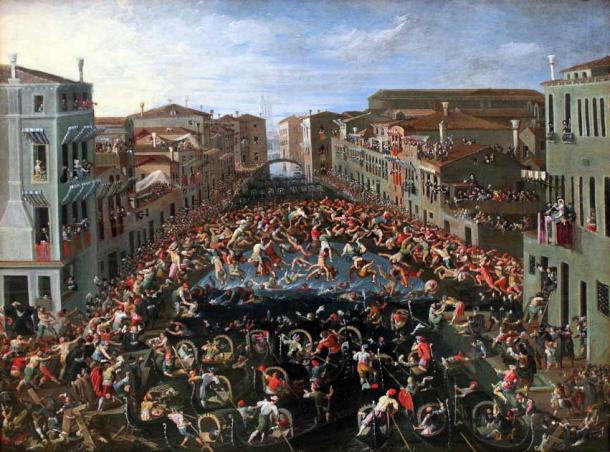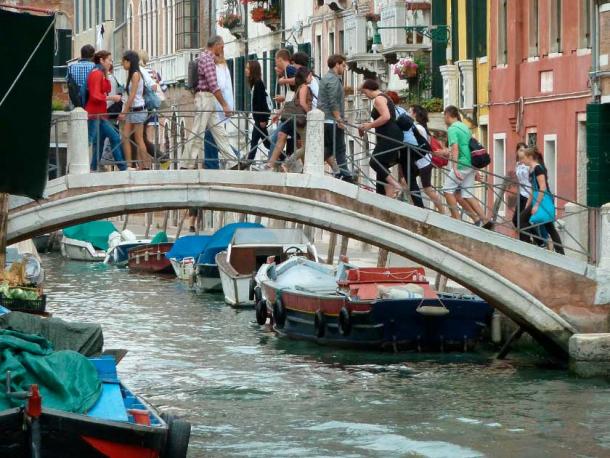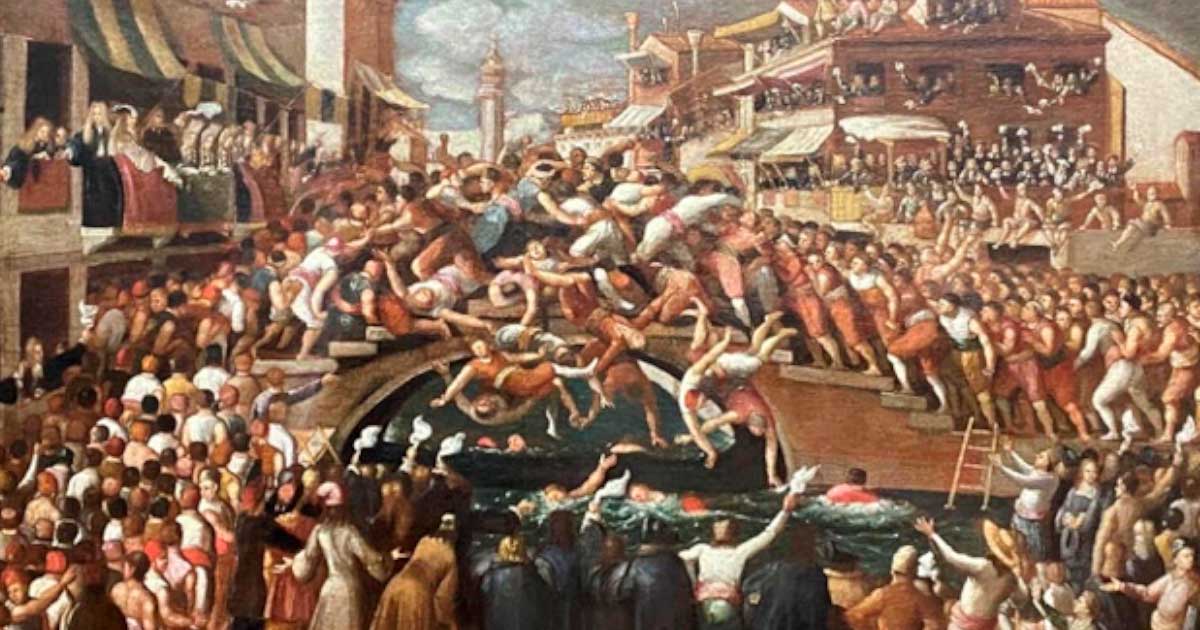Venetian Bridge Wars: The ‘Fighting Spirit’ of Renaissance Venice
For generations of Venetians, “guerra di canne” or “war with sticks” was a celebrated tradition. Throughout the Middle Ages and Renaissance periods, Venice was divided into many different administrative districts, each with its own rival factions. These factions would regularly meet up on the bridges of Venice to engage in fights with fists and sticks. So, how did the Venetian bridge wars come about, what were they like, and why did they end more than 300 years after they began?
The Earliest Venetian Bridge Wars Set the Tone
The first of these so-called stick wars or Venetian bridge wars was recorded in 1369 AD, although they did not begin to occur on bridges until 1421. These wars quickly became a point of pride for the people of Venice, with the government organizing fights to entertain honored guests, usually diplomats and ambassadors.
It wouldn’t be until the 1500s and 1600s, however, that bridge wars would really explode in popularity. It was then that these bridge wars became even more intense, with men out to achieve personal and group honor by defeating members of a rival faction.
- The Evolutionary Reason for Beards – a Hairy Shock Absorber
- The History of Boxing: Gory Gladiatorial Origins, Back Street Venues, and Big Money
By this stage, the battles had evolved into “battagliole sui ponti” or “little battle on the bridges.” These were prearranged fights, usually on Sundays or holidays. By now, factions fought not just for honor but also to gain control of a bridge.
As one Venetian citizen put it, “The purpose of our combat and contests is not to kill each other or tear each other apart, but only, in the presence of the city, to win and to take possession of the bridge, with competition and with the usual audacity.” These battles had become a sport that drew huge crowds. People even began to bet on the outcome of the battle.

Competition on the Ponte dei Pugni, painted by Joseph Heintz the Younger, in the time of the Venetian bridge wars, which were fought increasingly with fists in the 1600s. (Joseph Heintz the Younger / Public domain)
The goal of the battle was usually to throw your opponent off the bridge, as the bridges had no guardrails in those days. Since there were only two ways on to or off the bridge, it meant these street fights were more organized and confined than an open land duel that could quickly turn into a chaotic melee.
The bridge wars were fought with sharpened sticks, meaning severe injuries and deaths were very common. The crowds would often get involved too and would begin throwing tiles from the roofs down onto the bridge. Many people also died by drowning or being trampled by the crowd.
By the 1600s, the sticks had become outlawed, and the fights became unarmed brawls. These were known as “guerre di pugni” or “war of the fists.” By this stage, the Venetians had become well known for their fighting skills, and the bridge wars began to attract fighters and wrestlers from the surrounding states. One-on-one boxing matches were commonly held before the bridge wars during this time. The winners of both the boxing matches and the subsequent wars were ultimately decided by the crowd who applauded those who acted honorably and hissed at those who acted cowardly.
The biggest rivalry in Venice
The most famous of these rivalries was between the Castellani and the Nicolotti factions or gangs. The Castellani were from the eastern part of the city and were mostly employed by the shipyards and workshops. The Nicolotti lived in the eastern part of the city and were fishermen.
Their rivalry was the source of endless gossip and entertainment among the Venetians for centuries. The two factions would regularly challenge each other to games such as bull running, bear baiting and, of course, bridge wars that drew hundreds and sometimes thousands of spectators.
According to legend at least, during a stick war in 1585, the Castellani clan, seeing that they had lost most of their weapons and were outnumbered by the Nicolotti clan, threw off their protective gear and offered to fight mano-a-mano. This may have been the origins of the “guerre di pugni” or “war of the fists.”

It is difficult to imagine that the Ponte dei pugni bridge in Venice, as it looks today, was a fist-fighting battleground in the 1500s and 1600s. (Abxbay / CC BY-SA 3.0)
How the Venetian Bridge Wars were Banned
The last of these “war of the fists” took place on September 29, 1705. This fight began as usual, but it soon broke into a full-blown riot. Roof tiles were fired down onto the bridge by spectators, while the participants drew knives and daggers. The people had become so worked up that nobody had noticed that the church of San Girolamo had caught fire. The firemen were busy throwing punches in the battle. By the time one of the priests had come running to the bridge with his crucifix, the church had already been burned to a crisp.
- Battles on Ice Skates in the 1500s: The Dutch Against The Spanish!
- Snow Snake, The Ancient Native American Winter Sport, Gets Popular
The deeply Catholic state decided that the fights had gone too far and the Council of Ten (a major governing body in Venice) decided to ban the bridge wars. Although the fights were banned, rival factions still needed a way to channel their desire to win honor for their faction.
Other forms of competition became popular such as regatta, a rowing competition. ‘Forze d’Ercole’ or human tower building was another popular competition. Unfortunately, the rivalries still caused hatred among rival factions and these tamer forms of competition often still ended with violence. After a particularly violent riot in 1810, those competitions gradually declined as well.
Today, there are no more Castellanis vs. Nicolottis wars in Venice, but the bridges they fought on still remain. The most famous of these is the Ponte dei Pugni which means ‘bridge of fists’. Here, four marble footprints were added in 2005 to mark the starting places for the fighters who have been memorialized in poetry, painting and myth since their heyday in Renaissance Venice.
Top image: This painting, from circa 1675 by Joseph Heinz the Younger, shows a wild Venetian bridge war on the famous Ponte dei pugni bridge. Source: Joseph Heintz the Younger / CC BY-SA 4.0
By Mark Brophy
References
Black, A. 9/8/2016. Ponte dei Pugni [Bridge of Fists]. Atlas Obscura. Available at: https://www.atlasobscura.com/places/ponte-dei-pugni-bridge-of-fists
Fielding, H. 19/3/2019. The bridge wars of Renaissance Venice. Available at: https://hannahfielding.net/the-bridge-wars-of-renaissance-venice/
Patowary, K. 1/10/2019. Fist Fights on Venetian Bridges. Amusing Planet. Available at: https://www.amusingplanet.com/2019/10/fist-fights-on-venetian-bridges.html
The Association for Renaissance Martial Arts. Battling at the Bridge: Stick Fights and Boxing Spectacles
in Renaissance Venice. Available at: https://www.thearma.org/essays/BridgeWars.htm#.YvvjIHbMK5f

















